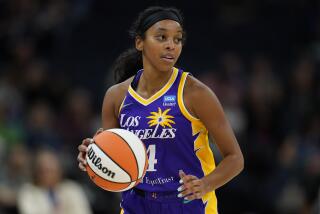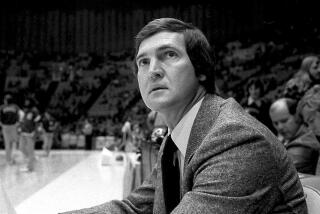Commentary : The Old Wave Reflection of a Knicks Fan
- Share via
I’ve been a New York Knickerbockers fan since ...
The radio had to be turned so low that only Matt and I could hear Marty Glickman’s pulsating account of the National Basketball Association games from the 69th Regiment Armory or Madison Square Garden in New York, Tri-Cities, Baltimore, Syracuse, Rochester, Fort Wayne, Toronto or wherever they chanced to be.
We knew Glickman. Everyone in earshot of New York sports radio knew Marty Glickman. And we got to know those early Knicks, though we did it secretly and at peril to our radio privilege in the dead of night.
He was in one bed, I in the other, with the radio on a night table between us. We took turns covering the lighted radio dial with our hands. Our heads were so close together they almost touched. It was the only way. If we were caught, the radio would be confiscated. Some of these broadcasts didn’t finish until 11 or 12 o’clock. The chickens rose at dawn on our little egg ranch, and the school bell rang early.
“Over the midline comes Braun. Back of the key hole to Van Breda Kolff; now Vanderweghe has it; into the corner it goes to Clifton and back out to Braun. Carl sets ... shoots ... Good, like Nedicks, where you eat well and save money, too.”
Glickman’s call of a game was an accurate, rapid-fire description in a voice that set fire to the imagination. To young bumpkins, it was as close to major-league heaven as one could get.
The Knicks were charter members of the NBA, formed in 1946. College basketball was king in New York with City College, NYU, LIU, Manhattan and Fordham the chief attractions. Glickman was already widely known as a college basketball play-by-play man because he was the first to describe the sport on the radio. Thus, he was as important to the infant league as any player.
“Red Barber and Mel Allen were the most famous baseball announcers,” Glickman said Wednesday from Liverpool, N.Y. “Ted Husing and Bill Stern were football’s top voices and Foster Hewitt, with the CBC in Canada, and Bert Lee in New York, were the best going at hockey. But basketball really had no one.”
It did when Glickman joined the show. He did not broadcast the first game the Knicks ever played in 1946 against the Toronto Huskies, but he was in the booth for the second game, against the St. Louis Bombers.
“(Owner) Ned Irish thought city people would identify best with New York college players. The first captain was Ossie Schectman of LIU, an authentic All-America and a terrific captain,” Glickman recalled. “Also in the early years, there was Ralph Kaplowitz from NYU, Dick Murphy from Manhattan, Bob Mullens of Fordham and Leo Gottleib, who was a great high school player in the city.”
Gottleib and Schectman were in the Knicks’ very first starting lineup with Stan Stutz (Rhode Island), Jake Weber (Purdue) and Ralph Kaplowitz (NYU).
Devastating point-shaving scandals hit the New York colleges in the early 1950s. “College basketball came back strong everywhere but in New York,” Glickman said. “To draw people to the Garden, they would book the Harlem Globetrotters in to play and the Knicks would play right after. There would be a big crowd, but everybody would leave when the Trotters game was over.”
The young league set up branches in strange places. Waterloo, Iowa, had a team in the Western Division in 1949-50. Ambitiously, the NBA had expanded to 17 teams in three divisions. “The Waterloo Hawks played in an armory that seated maybe 4,000 people,” Glickman said. “It was heated by a huge blower situated very high on the wall at one end of the court. Whenever the Knicks were shooting at the basket at that end of the court, the blower was on. Never while the Hawks were shooting at it. So every time they put up a shot it would be a floater, a knuckleball.”
The teams that thrilled Matt and I in the dangerous hours of many a winter school night were the ones coached by the Big Indian, Joe Lapchick, featuring Braun, Ray Lumpp, Vince Boryla, “Tricky” Dick McGuire, Harry “The Horse” Gallatin, Connie Simmons, Van Breda Kolff, Vandeweghe ...
“Ernie (Vandeweghe, father of modern-day pro Kiki Vandeweghe) was a tremendous guy,” Glickman said. “A medical student who joined the Knicks out of Colgate. His med school schedule was such that he would arrive at the game just in time to play. He would get dressed in the rest rooms of airplanes and come to the arena ready. I can see him now coming on to a court still lacing his sneakers.”
And I can hear Glickman now, describing the game, or the hot air blower in Waterloo or the tracks running into the trolley barn that was converted into a basketball arena by the original Baltimore Bullets. Or any of the rest of it.
Today’s top New York broadcasting voice, Marv Albert, was a Knicks ballboy whom Glickman says he “took under my wing in the 1950s. He was a good kid. Wanted to be a broadcaster.”
The rich young Knickerbockers of 1989, and their splendid coach, Rick Pitino, have returned winning pro basketball to New York, and Albert is as good as they make ‘em.
I can’t speak for my brother, but I don’t stay up nights listening to the Knicks anymore. For one thing, there’s not much of a kick to it if you’re not putting one over on your mother and father. My parents let me stay up as late as I want to these days.
But I’m still a Knicks fan and hope they win it all.
More to Read
Go beyond the scoreboard
Get the latest on L.A.'s teams in the daily Sports Report newsletter.
You may occasionally receive promotional content from the Los Angeles Times.










